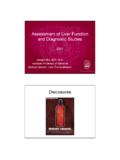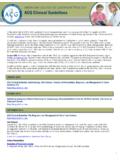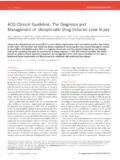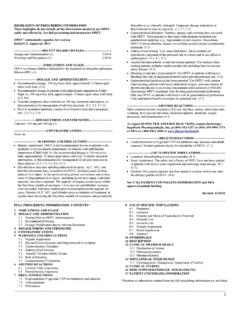Transcription of REVIEW Sepsis-Induced Cholestasis - SLAOP
1 REVIEWS epsis- induced CholestasisNisha Chand and Arun J. SanyalJaundice and hepatic dysfunction frequently accom-pany a variety of bacterial infections. The relationshipbetween sepsis and jaundice, particularly in a pediat-ric population, was reported as early as result either directly from bacterial products or as aconsequence of the host s response to infection. Fre-quently, both factors contribute to the development ofjaundice. In addition, specific infections that target theliver may cause jaundice because of the liver injury asso-ciated with hepatic infection. Although jaundice may bean isolated abnormality, it is often associated with featuresof Cholestasis . In critically ill patients, the development ofjaundice and/or Cholestasis complicates the clinical pic-ture and poses a clinical challenge both in diagnostic eval-uation and in management.
2 In this article, we REVIEW thecurrent concepts about the pathogenesis of jaundice andcholestasis with infection, their clinical presentation anddiagnostic assessment, and the optimal management ofthese clinical ConsiderationsJaundice is a well-known complication of sepsis or ex-trabacterial infection. sepsis and bacterial infection areresponsible for up to 20% of cases of jaundice in patientsof all ages in a community hospital inci-dence of jaundice in newborns and early infants variesbetween 20% and 60%.3 There are no data from large-scale prospective studies on the incidence of hyperbiliru-binemia in adults with sepsis . Several small retrospectivestudies have reported widely varying numbers, from 54%. This variability probably reflects both the report-ing bias and the populations of subjects studied (Table1).
3 4,5 sepsis is more likely to manifest with jaundice ininfants and children than in adults. In this population,males have a higher incidence of jaundice. However, inadults, no gender predilection has been has been associated with infections caused byseveral organisms including aerobic and anaerobic gram-negative and gram-positive bacteria. Gram-negative bac-teria cause most of these cases. The primary site ofinfection is most often intraabdominal, but infection ofvarious other sites such as urinary tract infection, pneu-monia, endocarditis, and meningitis have been associatedwith this ,6,7 Other specific infectionsknown to cause jaundice are infections of the hepatobili-ary tree, clostridial infection, typhoid fever, and jaundice can occur in isolation in patientswith septicemia, it is frequently associated with other el-ements of Cholestasis .
4 Because the principal clinical man-ifestation of Cholestasis is also jaundice, the publishedliterature has primarily focused on the syndrome of jaun-dice, and the exact incidence of Cholestasis with jaundiceversus isolated jaundice remains pathogenesis of jaundice in systemic infectionsis multifactorial. The development of jaundice mayoccur from an aberration in the processing of bilirubinby hepatocytes or from other effects on the liver thatlead to the accumulation of bilirubin in the body. Suchprocesses include increased bilirubin load from hemo-lysis, hepatocellular injury, and Cholestasis from theseptic state and from various drugs used for the treat-ment of sepsis . The molecular and biochemical mech-anisms by which jaundice develops in subjects withsepsis is best considered in the context of normal bili-rubin Bilirubin MetabolismBilirubin is the end product of the breakdown of theheme moiety of hemoproteins.
5 In humans, 4 mg of bili-rubin is formed daily from the degradation of hemopro-teins, 80% of which is derived from bilirubin is a highly hydrophobic moleculeand circulates tightly but reversibly bound to albumin inAbbreviations: AHA, autoimmune hemolytic anemia; BSEP, bile salt exportpump; BSP, tetrabromosulfophthalein; cMOAT, multispecific organic anion trans-porter; DIC, disseminated intravascular coagulation; IL, interleukin; KCs, Kupffercells; LPS, lipopolysaccharide; MRP2, multidrug-resistance-associated protein; NO,nitric oxide; NTCP, sodium-dependent taurocholate cotransporter; OATP, organicanion transport protein; RBC, red blood cells; RES, reticuloendothelial system;SLCT, sulfolithocholyltaurine; TNF, tumor necrosis the Division of Gastroenterology, Hepatology and Nutrition, Departmentof Internal Medicine, Virginia Commonwealth University Medical Center, Rich-mond, May 28, 2006; accepted October 16, reprint requests to: Dr.
6 Arun J. Sanyal, Professor of Medicine, Pharma-cology and Pathology, Virginia Commonwealth University Medical Center, MCVBox 980341, Richmond, VA 23298-0341. E-mail: 2006 by the American Association for the Study of Liver online in Wiley InterScience ( ).DOI conflict of interest: Dr. Sanyal received grants from Sanofi-Aventis Figure 1 shows normal bilirubin metabolism atthe hepatocyte. Bilirubin dissociates from albumin at thesinusoidal, basolateral membranes of hepatocytes and istaken up inside in a carrier-mediated process that requiresinorganic anions such as Cl .6,9,10 Organic anion trans-port proteins (OATPs) are on the basolateral membranesof role in bilirubin transport has stillnot been directly established, but bilirubin is a presumedsubstrate of uptake into a hepatocyte, bilirubin isbound by a group of cytosolic proteins (mainly gluta-thione S-transferases, GST) that prevent its effluxfrom the cell.
7 Within a hepatocyte, bilirubin is conju-gated to monoglucuronides and diglucuronides by theenzyme uridine of bilirubin converts it from ahighly hydrophobic molecule to a relatively hydro-philic molecule that can be excreted into ,9 Bili-rubin glucuronides are excreted into bile against a steepconcentration gradient by a canalicular membrane pro-tein, the canalicular multispecific organic anion trans-porter (cMOAT), also commonly referred to as themultidrug-resistance-associated protein (MRP2).6,9,14 This process is the major driving force of bilirubintransport and is the rate-limiting step in bilirubin ex-cretion by the 1. Reports of Jaundice and SepsisAuthor (Year)N M/FAgeTB/DB (mg %) Alk PhosALT/ASTA gents of Infection Bacteremia Site of Infection Deaths NotesBernstein et al.(1962)98/12-8 weeks12-22/4-7E.
8 Coli(5)8 UTI (4)9 Paracolon (2)P. Aeruginosa(1)Streptococcus (grp A)Hall et al. (1963)1110/115-65 years2-17/.4-145-21 (KAU/100mL)Gr. Diplococci (5)Lungs (11)2 Hamilton et al. (196)2413/11 1 day-13weeks3-31/1-16E. coli(18)18 Urine (16)11A. Aeruginosa(4)Umbilicus (2)Eye (1)Kibukamusoke et al.(1964)2121/017-65 years3-278-19 (KAU/100mL)8-150/13-150 Lungs (21)1 Eley et al. (1965)52/335-54 years3-23/8-1511-26 (KAU/100mL)16-34/24-88(U/ml)Str. pyogenes(2)3 Intraabdominal (4)1E. coli(1)UTI (1)Proteus (1)Bacteroids (1)Vermillion etal.(1969)74/318-72 years5-24/4-163-26(mU/mL)1-3 (IU/ml)E. coli(3)7 Lung (3)6 Streptococcus (3)Intraabdominal (2)Pseudomonas (2)Pleural (1)S. aureus(2)Miller et al. (1969) coli(8)Appendicitis (9)0 Rooney et al. (1971)2219/31-3 weeks7-50/1-37E. coli(14)19 UTI (9)0 Proteus (3)CSF (1)Klebsiella (2)Umbilical (1)Miller et al.
9 (1976)3015/15 15-27 years2-20 (DB )mean 128 mean aureus(4)11 Pneumonia (9)13P. aeruginosa(2)UTI (6)ParacolonPeritonitis (6)Klebsiella (6)Soft tissue (4)Ng et al. (1971)66/02-8 weeks4-33/3-2120-41 (KAU/100mL)E. coli(5)4 UTI (6)0 Paracolon (1)Borges et al. (1972)138/52 months-3years3-31/2-1428-300/50-920(U/mL )E. coli(5)UTI (10)0 Proteus (5)Lung (4)Streptococcus (2)Staphlyococcus (2)Franson et al. (1985)2310/13 25-77 years2-24/2-1456-169423-3300E. coli(8)23 Lung (8)14 Klebsiella (3)Abdominal cavity(5)Staphylococcus (6)UTI (4)Streptococcus (2)IV catheter/graft/skin (3)HEPATOLOGY, Vol. 45, No. 1, 2007 CHAND AND SANYAL 231 Disorders of Bilirubin Metabolism DuringSystemic InfectionVarious mechanisms can lead to hyperbilirubinemiaalone during systemic infection (Table 2). These are dis-cussed in detail in the following Bilirubin Load/HemolysisThe development of hemolysis causes an increased bil-irubin load in septic individuals.
10 In early studies, hemo-lysis was believed to be the principal mechanism ofjaundice in light microscopy, Tugswell etal. found excess iron-containing pigment in the liver ofpatients with pneumonia and noted ferritin containinglysosomes in Kupffer was believed to be com-patible with hemolysis and secondary iron overload. Al-though hemolysis contributes to jaundice in sepsis , it isunlikely that it is the principal mechanism because thejaundice results from conjugated 3 lists various mechanisms of hemolysis in the set-ting of may occur by multiple mechanisms in thesetting of bacterial may be catego-rized as mechanisms of hemolysis (1) associated with nor-mal red cells and (2) related to underlying red cell severe forms of many infections from gram-posi-tive and gram-negative bacteria have been associated withhemolysis of normal red cells.







